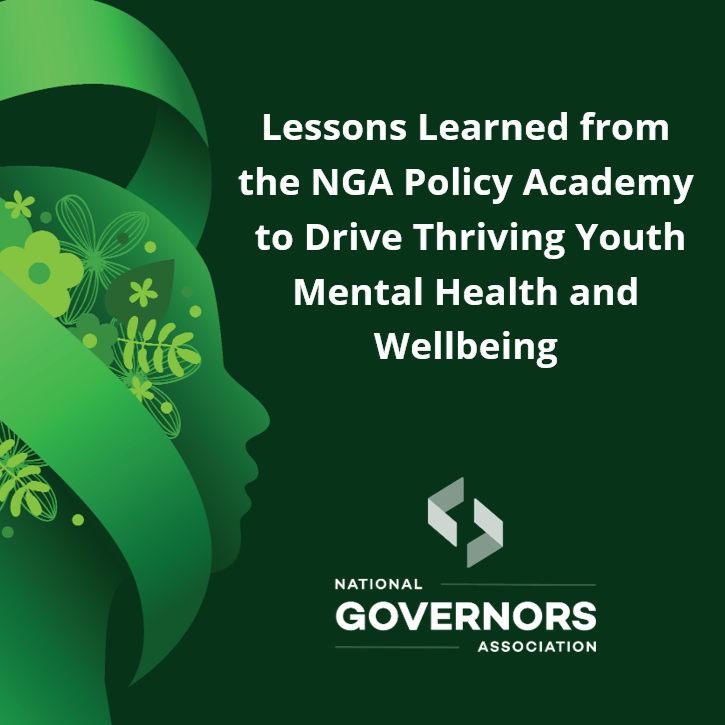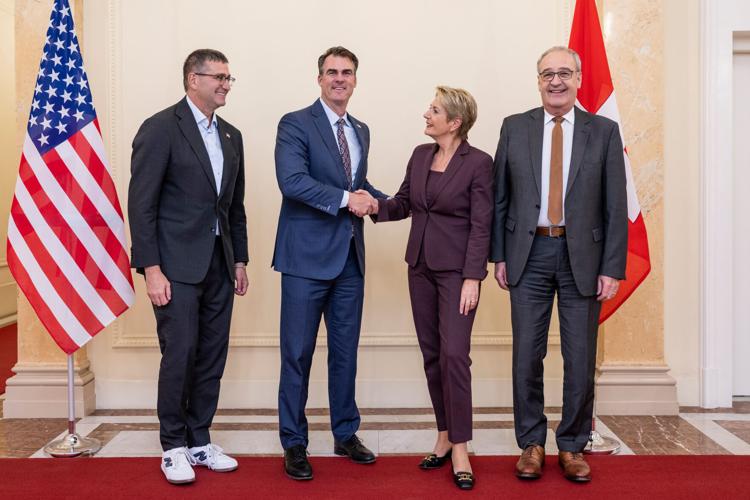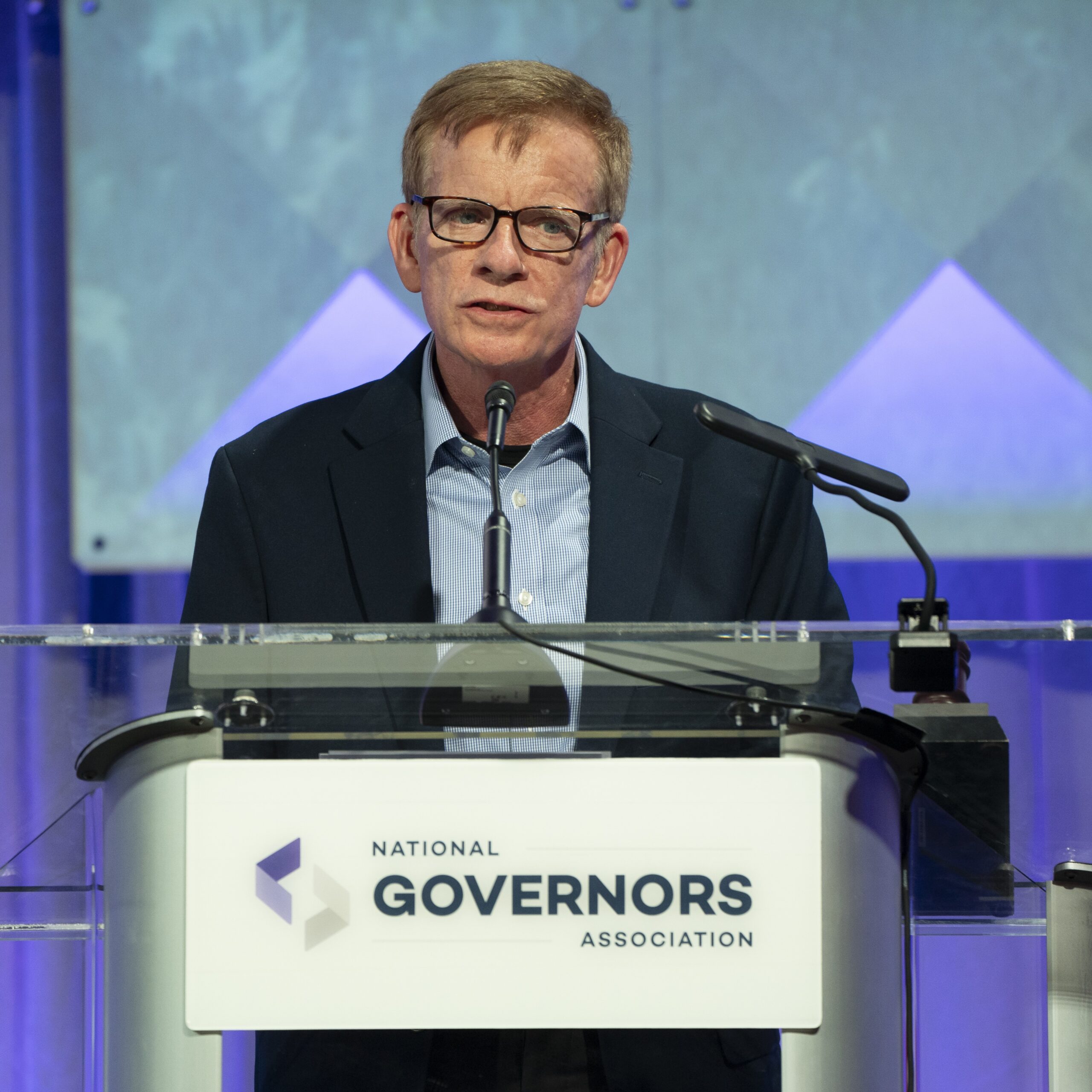This report expands upon findings from the Policy Academy to Drive Thriving Youth Mental Health and Wellbeing and provides guidance and insight to Governors and other state and territory policymakers seeking to advance change in their youth mental health systems.
(Download)

Five years since the onset of COVID-19 confined children within their homes and behind digital screens, communities are still grappling with the ongoing impacts of the pandemic, including a strained workforce, unprecedented levels of young people reporting mental health challenges and concerned caregivers struggling to get help for the youth in their lives. There are evolving questions within this landscape: How can states design services that better reflect and meet the needs of youth? How can schools support students’ mental health? How can policymakers navigate emerging concerns about social media and cell phone use?
Amidst the complexity, Governors are working to address the immediate crisis. To support those efforts, the Children and Families team at the National Governors Association (NGA) Center for Best Practices launched the Policy Academy to Drive Thriving Youth Mental Health and Wellbeing to facilitate in-depth technical assistance for six states. The technical assistance was provided from March 2024 to January 2025.
Six states – Alabama, Hawai‘i, Kentucky, New Jersey, Oklahoma and Virginia – were selected through a competitive process to receive technical assistance and other support to advance targeted reforms to states’ youth mental health systems. Participating states each developed individualized plans to address their needs, and all states sought to build collaboration and break down silos across agencies to yield whole-of-government solutions. Alabama, Hawai‘i and New Jersey undertook efforts to catalog programs and create resource inventories to analyze their current state systems and inform future policy decisions. Kentucky focused on strengthening its school-based mental health care system and supporting Medicaid “Free Care” services. Oklahoma explored a closed-loop referral system for youth referrals to mental and behavioral health services and explored mechanisms for including input from youth directly in state services by creating a youth council. Virginia developed a public-facing digital library, social media resources for youth mental health to promote mental health literacy and education and strengthened the state’s Medicaid services offered across the mental health continuum.
The progress and collaboration of the Policy Academy to Drive Thriving Youth Mental Health and Wellbeing led to several key reflections states and territories can heed when undertaking their own efforts, including:
- Develop an understanding of the current state system, either by collecting new data or leveraging existing sources;
- Creating a resource inventory is an iterative process that requires both buy-in and flexibility; and
- Both governance systems and individual relationships have an outsized impact on progress.
About this Report
The following report shares information about the structure of the Policy Academy and its outcomes. The report expands upon these findings and provides guidance and insight to Governors and other state and territory policymakers seeking to advance change in their youth mental health systems.
About the Policy Academy
The 2024 Policy Academy to Drive Thriving Youth Mental Health and Wellbeing was created as a follow-on to New Jersey Governor Phil Murphy’s 2022 Chairs Initiative, which resulted in the publication of A Governors Playbook to Strengthen Youth Mental Health. The Chair’s Initiative focused on taking a whole-of-government approach to improve youth mental health outcomes across the continuum, and the Policy Academy took a similar approach to the breadth of covered topics. The project was run in partnership with the Center for Best Practices K-12 Education and Health teams, and selected states were assigned an NGA facilitator who supported technical assistance requests and monthly team meetings.
Policy Academy States and the Learning Cohort (an informal learning network for states outside of the policy academy) also attended bimonthly 90-minute Cohort Calls focused on topics like data, communications, structured collaboration, workforce and financing. Through this effort, states received one-on-one research support, peer connection, and introductions to experts in the field.
Introduction
Whether within their homes, emergency rooms or pediatricians’ offices, a concerning number of children and families are struggling with mental health conditions. According to Mental Health America, in 2024, one in five youth aged 12 to 17 suffered a major depressive episode, and 56 percent of those youth reported they did not receive any mental health treatment. Further, according to data from the Health Resources and Services Administration’s (HRSA) Maternal and Child Health Bureau, only 60 percent of youth aged 6 to 17 are considered “flourishing” across measures of learning, resilience and self-regulation.
Flourishing is measured by three criteria: on a four-point scale of Always, Usually, Sometimes, or Never, how often does the youth 1. Show interest and curiosity in learning new things, 2. Work to finish tasks they start, and 3. Stay calm and in control when faced with a challenge? Youth who are considered flourishing rate as always or usually on all three questions.
Recognizing their power as state and territory executives, Governors across the country have been stepping up to improve these statistics and strengthen their youth mental health and wellbeing systems. In 2022, New Jersey Governor Phil Murphy focused his National Governors Association’s (NGA) Chair’s Initiative on strengthening youth mental health, which culminated in the publication of A Governor’s Playbook. The Playbook offers a wide range of policy solutions that states can advance across the continuum of care, dependent on their populations’ needs, existing systems and capacity.
Building upon Governor Murphy’s Chair’s Initiative and the Playbook, the Children and Families team at the NGA’s Center for Best Practices hosted a 10-month Policy Academy to Drive Thriving Youth Mental Health and Wellbeing. The Policy Academy, overseen in partnership with the NGA K-12 Education and Health teams, supported six states (Alabama, Hawai‘i, Kentucky, New Jersey, Oklahoma and Virginia), competitively chosen from 15 state and territory applicants, with technical assistance and project management support to help them advance youth mental health projects of their choosing. The goal of the Policy Academy was to help states operationalize the wide-ranging policy recommendations from the Governor’s Playbook and take advantage of lessons learned from the Chair’s Initiative to advance targeted youth mental health reforms. Technical assistance support included providing them with policy research as well as helping them refine goals, action plan, meet monthly to assess progress, connect to subject matter experts, and collaborate with peers.
In addition to the six state teams that received support from NGA, the Policy Academy employed a Youth Advisory Council, comprising individuals aged 18-30 selected by each of the Policy Academy state teams to provide their perspectives and inform the policy-making process throughout the project. The Policy Academy also cultivated a learning community called the “learning cohort” to afford additional states access and opportunities to learn along with the six selected Policy Academy states.
In addition to the monthly calls held with each individual Policy Academy state team, NGA hosted bimonthly calls with the Youth Advisory Council as well as with the broader learning cohort to increase awareness of the work, explore youth mental health-related policy topics, and build a community of practice nationally among state-level policymakers. Altogether, through the Policy Academy, the NGA team organized five bimonthly topical learning cohort calls, four off-cycle topic-specific calls, more than 70 virtual state team meetings, six in-person site visits and responses to more than 35 technical assistance requests.
The remainder of this report highlights the work of the six states in the Policy Academy and further expand upon the findings and recommendations listed above.
State Profiles
Alabama
State Team
- Governor’s Office
- Department of Education
- Department of Mental Health
- Department of Early Childhood Education
Goals: Build a collaborative partnership across child-serving agencies to inventory existing resources, evaluate the effectiveness and identify gaps in services to develop a strategic state plan focusing on improving youth mental wellness.
Policy Academy Progress
- Completed draft service and resource inventory with the Policy Academy agencies to prepare for distribution administration-wide.
- Policy Academy agencies collaborated to conduct initial gap analysis to identify areas with limited or no resources.
- To address initial gap areas and advance service and resource inventory completion, the Policy Academy group proposed an ongoing collaboration and is exploring utilization of the existing Children’s Policy Council to serve that need
- The Alabama Children’s Policy Council is a legislatively established body consisting of state officials and community representatives from a variety of sectors tasked with reviewing the needs of Alabama’s children and providing recommendations for the resources and services for state agencies to meet those needs.
- Applied for and awarded National Association of State Mental Health Program Directors grant funding to establish a Youth Advisory Council and provide financial assistance to participating youth.
Path Forward: As the Alabama team continues their collaborative efforts, they are focused on sustaining momentum to build consensus on the Children’s Policy Council and leverage that group to oversee the way agencies participate in the resource inventory and comprehensive gap analysis.
“The on-site assistance from NGA Policy Academy staff provided structured time and guidance that truly helped all team members engage and focus on the tasks at hand. The ongoing prompts and information provided from reviewing other states has helped expand our knowledge base and maintain momentum.”
Alabama State Team
Hawai‘i
State Team
- Governor’s Office
- Department of Education
- Executive Office on Early Learning
- Department of Health
- Department of Human Services
- Community Partners:
- Family Programs Hawai‘i
- Hawai‘i Youth Services Network
Goals: Build collaborative connections across state youth-serving agencies to share data, develop joint priorities and collectively advance legislative and executive policy change.
Policy Academy Progress
- Convened 55 partners facilitated by the NGA Policy Academy site visit to identify challenges and existing initiatives.
- Integrated NGA’s youth advisors into the Policy Academy team supported by NGA and the Hawai‘i Office of Youth Services to help include voices of youth with lived experiences and expertise.
- Conducted survey for resource directory with agencies that were part of the state team.
- Identified existing advisories, coalitions and initiatives with similar interests and launched a modernization of the Hawai‘i Interagency State Youth Network of Care (HISYNC) to ensure alignment and capacity to support statewide youth mental health policy progress.
- Strengthened collaboration amongst Hawai‘i team members working on youth mental health issues.
Path Forward: The Hawai‘i team is focused on finalizing the HISYNC updates, developing shared Key Performance Indicators (KPIs) for the Hawai‘i child-serving system, finishing the resource mapping initiated during the Policy Academy and continuing to elevate and integrate the role of youth and parents into the policy process in partnership with state agencies.
Kentucky
State Team
- Office of the Lieutenant Governor
- Department of Medicaid Services
- Department of Behavioral Health
- Division of Family Resource and Youth Services Centers
- Department of Education
Goals: Strengthen the school-based mental health (SBMH) services landscape in Kentucky by exploring how to better fund and finance SBMH services, equip educators to better identify and support both students’ and educators’ own mental health and establish a statewide SBMH coordinating body.
Policy Academy Progress
- Increased knowledge, awareness and understanding of Medicaid-covered services in schools, leading to an increased number of districts enrolled in Medicaid “Free Care” for schools.
- Secured a $2.5 million U.S. Department of Health and Human Services Center for Medicare and Medicaid Services (CMS) grant to continue to support school-based mental health (including training and technical assistance), support for different funding models to support student mental health and create a performance tracking tool for student mental health services.
- Applied for an AmeriCorps Youth Mental Health Corps planning grant to place mental health navigators in local school-based family resource and youth services centers and create a pathway for increasing the mental health provider workforce.
- Initiated planning for approximately six educator listening sessions to develop state-level recommendations for supporting educator mental health and wellbeing.
- With the leadership of the Kentucky Youth Advisor, the development of a peer resource tool/training for schools and districts to further use of various peer-to-peer models and resources to support student mental health.
Path Forward: The Kentucky team is looking to continue to increase the number of schools utilizing Medicaid “Free Care” services, develop a performance tracking tool to assess the progress of indicators related to student mental health across the state and use educator listening sessions to develop and publish recommendations for local and state-level policymakers to support teacher mental health and wellbeing.
New Jersey
State Team
- Governor’s Office
- Department of Children and Families
- Department of Health
- Department of Education
- Department of Human Services
- Office of the Secretary of Higher Education
Goals: Further interagency coordination to create a data-driven Statewide Youth Mental Health Strategic Plan informed by resource mapping and youth voice.
Policy Academy Progress
- Expanded interagency coordination by incorporating additional state agencies into the existing Youth Mental Health interagency working group.
- Conducted resource mapping to create a comprehensive database of state-provided youth mental health programming and a subsequent data survey to better understand current data collection and evaluation methods.
- Outlined a Statewide Youth Mental Health Strategic Plan to create a New Jersey-focused state-level analog of Governor Murphy’s NGA Chair’s Initiative Strengthening Youth Mental Health Playbook for Governors.
Path Forward: Utilizing the well-established interagency working group as a continued tool for collaboration, the New Jersey team is developing a statewide strategic plan by building upon the outline created during the Policy Academy. Through these ongoing efforts, the team is looking to continue and deepen youth engagement in the policymaking process.
Oklahoma
State Team
- Department of Mental Health and Substance Abuse Services
- Health Care Authority
- State Department of Education
- Department of Human Services
- Department of Juvenile Affairs
Goals: Strengthen the statewide youth mental health system in Oklahoma by fortifying and formalizing interagency collaboration, exploring the value and impact of establishing a statewide closed-loop referral system, where agencies can refer and coordinate care for youth across systems, and developing a functional and sustainable youth mental health advisory council.
Policy Academy Progress
- Released and reviewed responses to a Request for Information (RFI) for relevant stakeholders potentially impacted by a statewide closed-loop referral system.
- Analyzed past iterations of youth councils in Oklahoma to inform current best practices, developed handbook and application for youth advisors and designed participation expectations and anticipated outcomes of the Oklahoma Youth Mental Health Advisory Council.
- Strengthened interagency connections through the formality and structure of the Policy Academy, allowing for collaboration beyond the bounds of the Policy Academy on complex issues.
Path Forward: To continue momentum on progress made during the Policy Academy, the Oklahoma team will determine the resources needed to develop and manage a closed loop referral system, launch the inaugural youth council and determine scope and cadence of ongoing collaboration among the Policy Academy agencies.
Virginia
State Team
- Governor’s Office
- Office of the Secretary of Health and Human Resources
- Department of Medical Assistance Services
- Department of Education
- Department of Behavioral Health and Developmental Services
Goals: Promote youth mental health literacy and education; strengthen Medicaid services for youth within the mental health continuum through high quality, evidence-based, and trauma-informed care; and strengthen and sustain interagency collaboration amongst the Policy Academy team.
Policy Academy Progress:
- Completed shared vision setting and organizational governance environmental scan.
- Increased access to high quality mental health services for youth through Right Help, Right Now Behavioral Health Redesign.
- Virginia Governor Glenn Youngkin issued Executive Orders 33 “Cell Phone-Free Education to Promote the Health and Safety of Virginia’s K-12 Students” and 43 “Empower and Support Parents to Protect Their Children from Addictive Social Media & Establish the Reclaiming of Childhood Task Force” to protect youth mental health in the digital age.
- Created building blocks for youth mental health literacy, information and resources to empower parents, families, caregivers, and youth.
Path Forward: The Virginia team is looking to build on the foundations of the initiatives begun during the Policy Academy, including by launching the Virginia Youth Mental Health Resource Bank and creating a social media toolkit for youth mental health literacy; continuing to assess the existing Medicaid services system and operationalizing new services to fill existing gaps; and sustaining interagency collaboration by clarifying agency roles and responsibilities, establishing a regular meeting cadence, and designating main points of contact for each agency.

Technical Assistance Highlights
Kentucky
Kentucky’s project had a unique, narrow focus on school-based mental health (SBMH) services and, more specifically, on implementing Medicaid “Free Care” services. To that end, NGA assisted Kentucky’s efforts to assess and troubleshoot district-identified barriers to utilization. The project team examined existing claims data and utilized a point-in-time assessment to determine the administrative burden for delivering SBMH services to estimate a baseline of utilization and need. Additionally, the team developed and administered a survey to identify school-level barriers to further utilization, which uncovered the need for a sustainable funding source, as schools had been using temporary federal funding to cover staffing, namely Elementary and Secondary School Emergency Relief (ESSER) funds. The survey also exposed limitations on which medical professionals can utilize billing codes, challenges related to required start and stop times for services that left some amount of work unpaid, and limitations on performing eligible services during school hours. By addressing these issues, Kentucky was able to increase the number of schools utilizing Medicaid for the 2024-2025 school year and submit a stronger application for the CMS grant, ultimately securing $2.5 million in grant funding.
Virginia
Over the course of the Policy Academy, Virginia Governor Glenn Youngkin signed two executive orders (EOs): Executive Order 33 and Executive Order 43. Together, the EOs seek to protect youth in the digital age and provide scaffolding for coordinated messaging and support for youth, parents, and community leaders to prevent harmful social media and cell phone usage that negatively impacts youth mental health. In a parallel effort, the Policy Academy team sought to improve mental health literacy and service awareness, which the team operationalized by launching a website and social media toolkit. The project team’s efforts to reconcile these efforts with other state efforts ensured continuity and cohesiveness and supported a coordinated deployment of the Governor’s agenda.
Oklahoma
To support Oklahoma’s goal of developing a youth mental health advisory council, the project team reviewed details of other state and territory youth councils to guide design, including information on reporting structure, policy/area of focus, participant application requirements, eligibility, composition, requirements and expectations of service and compensation. Partnerships with organizations like Active Minds and Young Invincibles helped to inform the project team’s approach and guide best practices for youth engagement.
Lessons Learned
Start with a data dive: You need to know where you’ve been to know where you’re going
The value of data-informed decision-making is widely accepted across state government policymakers; however, decisions are often only as sound as available data. Data utilization was a key focus across participating states, though state teams varied in scope and methods. State teams faced two challenges: deciphering which data was most important to include in their decision-making, and how to gather valid information efficiently. Policy Academy teams fell loosely into two camps: 1) teams that created new inventories to document available services and resources; and 2) states that turned to existing or non-traditional data sources to develop an understanding of the landscape.
- States Developed New Resource Inventories to Assess Available Services and Gaps
- Three Policy Academy states (Alabama, Hawai‘i, and New Jersey) sought to advance comprehensive system change through the project. These states took stock of the current state-funded youth mental health services by developing resource inventories as an initial step to define their existing systems.
- States varied in the digital tools they selected to create these inventories: Alabama and New Jersey utilized Excel spreadsheets, and Hawai‘i created a Google form to support collection of responses from agencies. The benefit of the static Excel sheet was that state employees could fill out multiple programs at the same time, allowing users flexibility to leave and return to the document. Conversely, the Google survey afforded the Policy Academy team real-time access to information submitted about mental health programs.
- The NGA team provided a template of an example resource inventory and a sample guidance document to support states in their initial efforts. These inventories inquired about several categories including governing agencies, eligibility, funding streams, location and program charter. These documents can be provided to states upon request.
- States Utilized Existing Qualitative and Quantitative Data
- Three Policy Academy states (Kentucky, Oklahoma and Virginia) focused their projects on making more narrowly defined improvements within their youth mental health systems and creatively employed data to inform decision-making throughout their Policy Academy projects.
- States tapped into existing datasets, especially information on the utilization of mental health services, to understand their systems better. The Kentucky team compared demographic information to current utilization information to identify leading and struggling school districts at which to grow SBMH service usage. When Virginia developed the Youth Mental Health Resource Bank, the team identified and prioritized programs and services by looking at 211 (the state hotline to connect with community services) and Medicaid utilization statistics.
- Data doesn’t have to be just numbers: states also leaned on anecdotal information from state employees and constituent populations. Virginia partnered with the Virginia Family Network to help collect feedback from parents and youth on the design and content of the website. In Kentucky, the team prioritized collecting feedback directly from school staff to learn about successes and the barriers they faced delivering services and referring youth to other supports and developed processes to gather qualitative data through focus groups.
- Even informal conversations provided influential data: In Oklahoma, the Policy Academy team collected lessons learned from state department leaders on existing youth councils they operate to garner best practices and reduce duplicative efforts.
Buckle up: Creating a resource inventory is an iterative process
States found that determining the scope of the data they sought to examine was as important as the process they created to collect relevant information from agencies. State teams navigated debates on which resources should be documented in the inventory in addition to the specific data that should be collected for each program or service.
As they developed these inventories, states learned that the template itself didn’t need to be overly complicated, as simple and accessible tools like Microsoft Excel spreadsheets could suffice. However, determining the parameters, including decisions on what data to collect, which agencies to include, and the process for collecting and refining information could quickly become challenging and overwhelming. Many of the state teams needed to host a series of conversations to bring the group to consensus, to find the balance between collecting a comprehensive set of information and reducing unnecessary burdens on state agencies.
Ultimately, a critical lesson learned was to “not let the perfect be the enemy of the good.” To avoid decision paralysis, state teams acknowledged that they moved forward with incomplete inventories but could ultimately use these tools to build a more comprehensive understanding and refine data collection processes to streamline decision-making along the way.
Examples of Questions considered by participating states
- What defines a program as “related” to youth mental health?
- What age groups should be included?
- Should the inventory include community-based programs, or just state-run or grant-funded programs?
- Should the inventory ask about insurance eligibility?
- Should the inventory ask about specific demographic information of populations served, like income level, race or gender?
De-siloing systems starts and ends with individual relationships
Isolation is a widespread challenge across many policy areas, driven by siloed government programs, but fragmentation is particularly challenging when working to implement cross-cutting system change. A wide variety of agencies serve different needs of the same youth, and a holistic approach that builds on the strengths and delivery systems of multiple arms of government can yield greater efficiency. The lack of cross-agency collaboration can lead to duplicative services, gaps in needed services and frustrations for families who must interface with inefficient and disparate systems. From the project’s outset, Policy Academy states sought to reduce silos between agencies and increase collaboration. States’ team composition varied, ranging from team members with existing established relationships–both formal and informal–to first-time collaborators. Over the course of the 10 months of the Policy Academy, all participating states reported strengthened connections across agencies and greater partnership among team members.

Reflections from States—Improving Collaboration
Meetings: Can’t live with them, can’t live without them
Regular meetings had a critical impact on project momentum.State teams reported challenges in aligning team members’ schedules for regular check-ins, and the capacity challenges of state employees could have hindered progress without NGA project management support. Some teams also created their own internal check-ins and testified that these meetings ensured progress was made outside of the monthly check-ins.
Speak the same “language”
Teams had to make deliberate efforts to build shared definitions of terms to mitigate lexicon and process miscommunications across agencies. Kentucky hosted a series of one-hour team meetings during which they explained how different agencies interacted with the Medicaid system in the state and did deep dives into relevant topics to build a foundation for policy recommendations and future improvements.
Consistency is showing up
The state teams were diverse in agency representation and leadership, adapting to their own personnel needs and dynamics. The key to success in each of the teams was not necessarily dependent on where the team leaders sat; more important was the ability of the group to coalesce under a leader who had decision-making authority to guide the group forward.
Center practicality
The youth mental health landscape is incredibly complex (e.g., tight state and federal regulations, a tired workforce, and rising incidence and severity rates) which necessitated that almost every team adjust their goals or workplan over the course of the project as they discovered new information about their systems and built shared understanding across agencies. States were able to maintain progress toward their project goals by exhibiting a willingness to adapt to system needs or capacity.
Conclusion
The Policy Academy to Drive Thriving Youth Mental Health and Wellbeing demonstrated the critical importance of structured, collaborative approaches to addressing the youth mental health crisis. Through 10 months of intensive technical assistance and peer learning, the six participating states – Alabama, Hawai‘i, Kentucky, New Jersey, Oklahoma and Virginia – made meaningful progress toward strengthening their youth mental health systems while building sustainable foundations for continued improvement.
Significantly, all participating states reported intentions to continue their collaborative efforts beyond the Policy Academy timeline, indicating that the project successfully built lasting partnerships within states and fostered trust among traditionally siloed agencies. This sustained commitment to cross-agency collaboration represents a fundamental shift in how states approach youth mental health challenges, moving from fragmented, agency-specific responses toward coordinated, whole-of-government solutions. The investment in structured collaboration and data-informed decision-making represents not just policy progress, but a commitment to the wellbeing of young people whose mental health outcomes will shape the future of our communities. The National Governors Association stands ready to continue to support states and territories in their efforts to strengthen youth mental health and wellbeing in the future.
Acknowledgements
This paper was developed by:
- Brianna Keys, Consultant
- Jessica Kirchner, Senior Policy Analyst, Children & Families, National Governors Association Center for Best Practices
- Jordan Hynes, Children & Families Program Director, National Governors Association Center for Best Practices
This report was made possible by support from Pivotal Ventures, the Penner Family Foundation, Funders for Adolescent Science Translation, and The Annie E. Casey Foundation. The views expressed are those of the authors and do not necessarily reflect the opinions of the Foundations.












